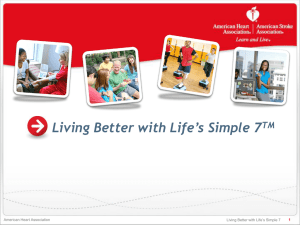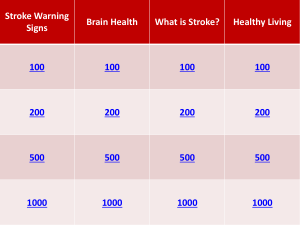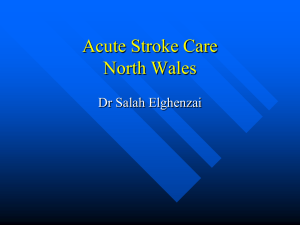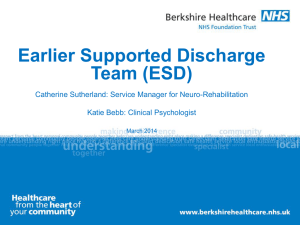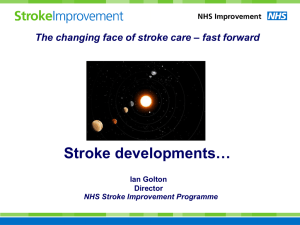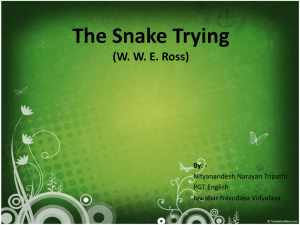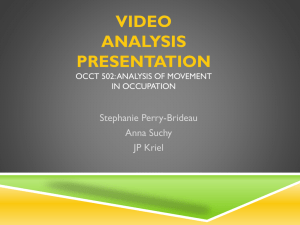Stroke in Stoke
advertisement
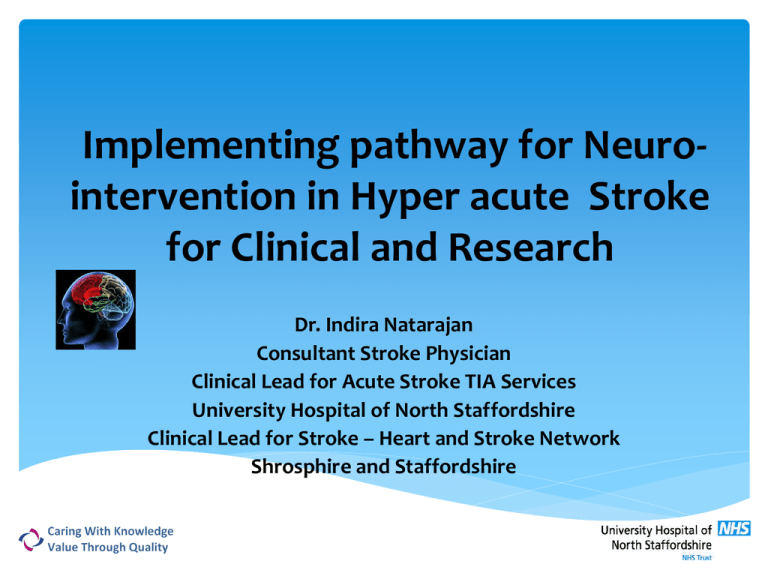
Implementing pathway for Neurointervention in Hyper acute Stroke for Clinical and Research Dr. Indira Natarajan Consultant Stroke Physician Clinical Lead for Acute Stroke TIA Services University Hospital of North Staffordshire Clinical Lead for Stroke – Heart and Stroke Network Shrosphire and Staffordshire UK National Stroke Strategy DH National Stroke Strategy 2007, page 32. There may be a role for interventional neuroradiology in the management of basilar thrombosis. Patients should have access to a stroke service with neuro-interventional capacity. A network approach may be required to develop an agreed protocol, so that each stroke unit is linked to a regional neurosciences centre for emergency review of local brain imaging- for example by electronic link- and emergency transport (and then repatriation) of appropriate patients. Strategic Health Authorities, through specialised commissioning arrangements, to support the co-ordination of the availability of specialist neuro-intensivist care including interventional neuroradiology and neurosurgery expertise…. BASP CS views There is a need for RCTs of endovascular treatments and UK stroke services should recruit patients to such trials once they are open. Endovascular treatments should not be offered routinely until evidence from RCTs is available Until such evidence is available treatment should be on a case by case basis guided by agreed treatment and referral pathways EVT should only be given in centres with agreed pathways and protocols including A&E, the stroke service, neuro-interventionalist, ITU and speciality nurses Participation in national register/ International registers Centres participating in RCTs will have to have experience in the procedure before enrolling patients. UHNS Acute Stroke Unit (ASU) 2001 to 2010 Outcome/Results 24 Beds 39 Beds Integrated working 32 Beds Death Ongoing Care 20 11 /1 1 20 07 /0 8 20 08 /0 9 20 09 /1 0 Home 20 05 /0 6 20 06 /0 7 20 01 /0 2 20 02 /0 3 20 03 /0 4 20 04 /0 5 100% 90% 80% 70% 60% 50% 40% 30% 20% 10% 0% Where are we? Regional Thrombolysis rota for 24/ 7 cover across the region ( Feb 2011) Telemedicine ( April 2012) Until 2010 No clear Neurointerventional pathway First encounter…….. December 2009 75 year old gentleman Recent cervical spine surgery 4 months ago Admitted with collapse and found unconscious GCS 4/15 Intubated and ventilated No reversible pathology Atrial fibrillation CT brain Normal study Cervical Halo Basilar occlusion on CTA Discussion with Orthopaedic Surgeon/ Neuroradiologist Agreed for Intravenous and intra-arterial Anaesthetist arranged Whole episode was chaotic Since no clear pathway - theatre team difficult to coordinate ODA had to be pulled off from Neuro-surgical theatre Significant amount of time lost from arrival of patient to A and E and before procedure commenced Time is Brain…… Pathway for ischaemic stroke treated with r t-PA? 999 Triaged in A and E Within 3 - 4.5 Hrs Neuro-interventional pathway 999 Time is Brain The Team Interventional Neurorradiologist 1 Radigrapher 1 Nurse Stroke Physician Anaesthetist / ODA Agreed patient group… Age<75 Previously fit and well Working hours (out of hours if interventional neuroradiologist available) Teams that we engaged Radiology / Neuroradiology Anaesthetics/ ITU Neurosurgery Emergency Medicine Radiology protocol Yellow sheet for Stroke patients CT brain and CT angiogram as agreed protocol CT head scan Order a non-contrast CT head immediately after arrival (urgent e.g. within 1 hour) for all strokes. [label form ACUTE STROKE call 4042 (daytime) or on call radiologist (nights, weekends and holidays)]. Thrombolysis candidates and patients on warfarin must be scanned immediately (within 15 min) Order a CT angiogram (arch to Circle of Willis) if <75 y and no contraindications to contrast and within < 8 h of onset and no haemorrhage and no signs of established infarction on the CT head scan. Neuro-radiologist / Stroke Physician alerted when CT angiogram findings which suggests need for IA intervention Carotid T occlusion (intracranial carotid bifurcation occlusion with involvement of A1 and M1 segments) M1 (trunk of the MCA) or M2 (MCA branch in Sylvian fissure) occlusion Vertebro- basilar thrombosis To get a Standard Operation Pathway agreed for Stroke as E 1 Emergency theatres prioritisation codes E1 E2 E3 E4 Immediate transfer to theatre Within 6 hours Within 12 hours Urgent, but timing not critical Potential indications for EVT Primary intra-arterial thrombolysis Severe disabling neurological deficit and Contraindications to iv thrombolysis (e.g. recent surgery), 3-6 h from symptom onset Intravenous/ Intra-arterial /EVT Severe disabling neurological deficit and Large vessel occlusion in MCA Brain stem stroke Treatment can be delivered within 9 h of symptom onset and Occlusion of basilar artery documented on 4-vessel angiography Eligible even if consciousness impaired and or patient ventilated Key paperworks…… Consent Sheets form 1 / form 4 Patient information sheet Theatre check list IA log Nursing pathway for Intervention Time CT angio IV alteplase given Y / N Time of IV alteplase bolus Consent/assent signed Y / N Time of last micturition (offer bottle & conveen) Arrival time in cathlab Anaesthesia GA / LA Start time of GA/LA Time of femoral puncture = start of procedure Start time catheter angio Catheter used for angio IA lysis done Y / N Catheter used for IA lysis Time of IA catheter at clot Time first dose of IA tPA Time last dose of IA tPA Total dose of IA tPA Total dose of IV & IA tPA Mechanical Thrombectomy Device used for MT Stat time of MT No of attempts of MT Time of clot capture Time of final catheter angio = end of procedure Time of post procedure CT (after final angio) Time out of cathlab Arrival time in stroke unit Y / N Suitable patient Potential patient for IAT/MT identified Fit for GA/ thrombectomy Previously independent NIHSS>=10 or basilar artery thrombus No bleed or sub acute infarct on CT head CTA shows large vessel occlusion (ICA/M1/M2/ VA/BA/ PCA) Lysis Protocol Start iv lysis while waiting for theatre. Give 0.6 mg /kg alteplase (bolus and infusion) iv unless iv lysis is contraindicated (recent surgery, post-partum). Leave 0.3mg/kg (max 30 mg) for i.a. lysis. Do CT head immediately post procedure and after 24 h. Stay with patient until awake and settled on stroke unit. Ensure patients is monitored according to the IAT nurse pathway. Pathway in action…. Keep next of kin on site for consent /queries or establish contact route Clinician (stroke physician / A&E doctor) to get an anaesthetist STAT: neuro-anaesthetist, if possible, otherwise on call: contact via switch Clinician (Stroke physician / A&E doctor) to inform ODA Out of hours Arrange for an anaesthetist – go to online services / rota watch / on call anaesthetist – bleep 3rd on call Radiologist to get radiographer and scrub nurse for the procedure. Set up operating trolley and equipment immediately. Inform Stroke Unit for arranging a bed – Stroke team Prepare the patient (A&E staff/ stroke team/ neurointerventionalist) Discuss procedure Complete consent form Complete theatre checklist (inside the consent form) Put patient into a theatre gown Offer bottle or catheterize Put in IA line (in A&E or theatre) Transfer to neuro-interventnional theatre Prepare for intervention Start the intra-arterial intervention log Theatre team to move patient onto the intervention table Theatre team to cover patient with sterile sheets Anaesthetist and ODA to commence local/ general anaesthesia Neuroradiologist or scrub nurse to clean/ disinfect groin. During / After Intervention Complete intra-arterial intervention log Remove catheter/ intra-arterial line Liaise with ASU to alert team about patient transfer Get a bed tracked to the intervention suite to transfer patient to ASU Patients who were ventilated before the procedure may need ITU/MIU. Regional referral protocols…. Devised protocols through our Heart and Stroke Network for regional DGH’s Clear pathway for in hours and out of hours Drip and Ship with escort We have accepted patients outside our region on occasions Barriers….. Trust Commissioning Costing Getting all the teams together Media – Not a good idea Tuesday, February 09, 2010 Pioneering stroke drugs saved Patient This is Staffordshire FATHER-OF-FOUR owes his life to being at the right place at the right time after suffering a massive stroke . The attack was severe enough to give him just a 20 per cent chance of surviving. • Costings…… Consumables overall £ 1600 Device cost ranges roughly around £ 4000 ( prices can be negotiated depending upon trusts) Average use of devices is around 1.5 (from our experience of 50 cases) Out of hours theatre staff cost £ 500 -------------------------------------------------------------------------------------------- Overall rough cost estimate is around £ 6100 Cost for Post Stroke Care Hospital Care Basic bed day in Stroke unit: £ 170 /day With added costs : £ 350/ day Patients with mRs 4 and 5 average LoS: 90 days Cost for 90 days: £ 31,500 Social / Residential care: mRS 5 : £550 / week ( £ 28,600/ year) mRS 4: £ 400 - £ 450 /week ( £ 20,800 - £ 23,400/year) mRs 3: ( if care required) : £ 300/week ( £ 15,600/year) Funding Primary Care Trust NHS Stroke Network Stroke Fund Intervention Fund Neuroscience Department Geriatric Medicine Under discussion 2 2 1 1 1 1 1 1 HRG Coding Percutaneous trans-luminal embolectomy / thrombectomy of artery: L 712 HRG - QZ15 A - Major complication with comorbidities £ 9554 HRG – Q Z15B – Minor complications £ 5098 HRG – QZ15 C – No complications £3731 On top for Alteplase: you get another 800£ Challenges 24/ 7 Sustainability Reliant on key individuals Job Plan Integrated pathway agreement with other centres Need to demonstrate quality before taking part in Research trials Centres in the UK > 1 per month 5 – 10 / 10 months Frequency of endovascular treatments for acute ischaemic stroke in active centres in 2010 Number of centres 0 4 1-4 (1 every 3 mo or less) 8 5-9 (one every other month) >=10 5 6 Capacity, organisation, and quality control ( Nationally) 23 active centres 71 interventional Neuroradiologists in the UK in 2010 46% of centres not providing EVT had no procedures for referral to centres providing such treatments. 56% of centres providing EVT entered patients into the SITS register 56% of centres providing EVT entered patients into the SINAP Type of Approach Thrombolysis pathway Neuro-interventional pathway In Summary Newer interventions needs newer pathway Part of expansion of Neurosciences Units Part of the Clinical Research activity One needs to start somewhere……………….. Resources http://www.stroke-in-stoke.info/ You can look at our: Pathway Patient Information leaflet Procedure log Nurse pathway Protocols Data entry file – We are happy to support data Acknowledgements…. Prof Christine Roffe Dr. Sanjeev Nayak All the Neuro-interventional team / Anaesthetic team/ ITU team / Stroke team/ Exec Board

